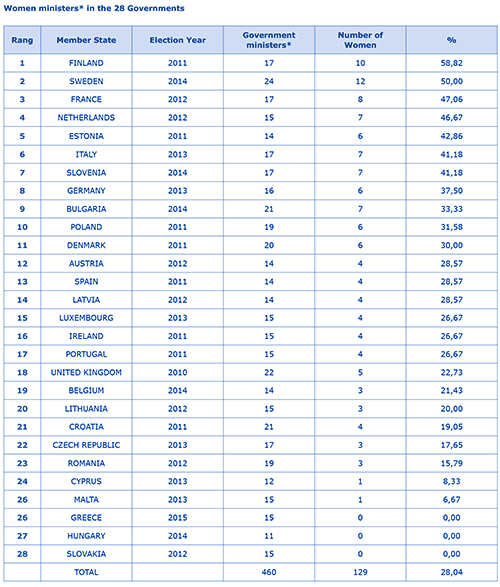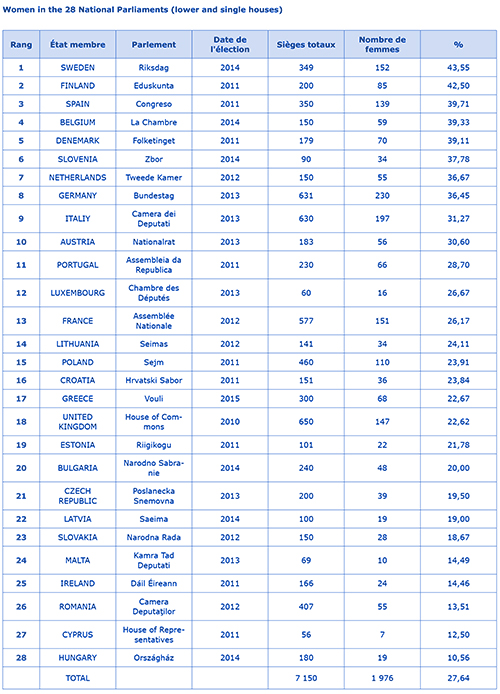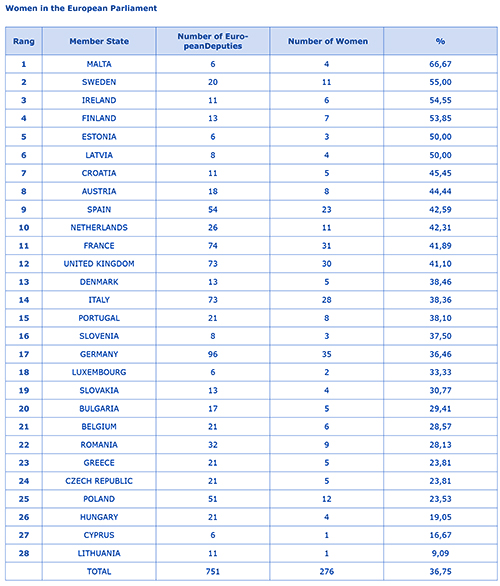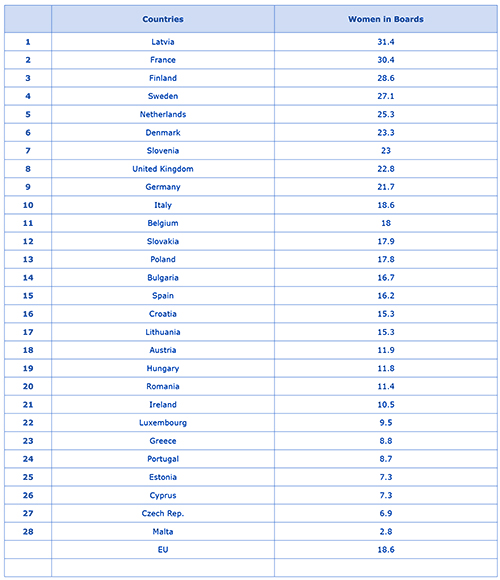Gender equality
Pascale Joannin
-

Available versions :
EN

Pascale Joannin
There are two women heads of State: Dalia Grybauskaite, President of the Republic in Lithuania and Kolinda Grabar-Kitarovic President of the Republic in Croatia since 18th February 2015.
In Europe as a whole there are nine women in the highest positions of State: a Prime Minister in Norway, Erna Solberg, a President in Kosovo, Atifete Jahjaga and a President in 2015 in Switzerland, Simonetta Sommeruga.
However Europe is the continent where women's lot is the best. In many regards it is a model for the rest of the world.
In Parliaments for example 22% of MPs in the world are women. Amongst the 28 Member States of the European Union they represent on average 27.7% of MPs; in the European Parliament, 36.8%! These are the highest levels in the world. Indeed only 26.5% of MPs are women in America, 23.4% in other European countries, 22.4% in Africa, 19% in Asia, 18.1% in the Arab countries and 13.1% in the Pacific region.
And so Europe is still the continent where women are the best represented.
2014 was the year of renewal for the European institutions. Did this lead to an improvement in the situation in Europe? What can we conclude in terms of women's involvement? Has Europe honoured all of the women in the world who see it as a model?
What place has been reserved for women in the European institutions?
Review after the renewal of the institutions
It would have been quite easy to come to agreement and effect parity on a European level and appoint two women out of the four possible post to lead the renewable institutions in 2014 (Parliament, Commission, Council, High Representative).
In this regard 2014 did not bring about any progress. One woman only, Federica Mogherini, was appointed as the EU's High Representative for Foreign Affairs and Security Policy, and Vice-President of the Commission. She succeeds Catherine Ashton who had occupied the same post since 2009.
The same applies to the European Commission. Of the 28 Commissioners we might have expected parity within the community executive with the appointment of 14 women. Indeed for the first time since 1992 the European Union has an even number of Member States and the implementation of parity would have been beautifully symbolic. It was an excellent opportunity to finally implement the principle of equality between men and women as it is written in the Treaties by appointing 14 women out of the 28. But this did not happen because the heads of State and government did not want to appoint women.
Hence the European Commission includes 9 women, in other words the same number as in the outgoing Commission led by José Manuel Barroso. They represent slightly less than one third of the Commissioners (32.1%).
Jean-Claude Juncker, the Commission's President, did however demand the appointment of more women. He struggled to counter the ambient conservatism and use all of his political influence for there to be no less than in 2009! He was supported by the European Parliament which threatened not to invest the European Commission. Let this be a warning to his successor!
But he knew how to respond. The women appointed were given important portfolios. Apart from Ms Mogherini a second Vice-President Kristallina Georgieva, is responsible for the Budget. The others are in charge of competition (Margrethe Vestager), trade (Cecilia Malmström), employment (Marianne Thyssen), the internal market and industry (Ezlbieta Bienkowska), transport (Violetta Bulc), justice (Vëra Jourova) and the regional policy (Corina Cretu)
In the European Parliament 275 women were elected on 22nd-25th May 2014, and represent 36.8% of the 751 MEPs. The progress has been slight in comparison with the previous election in 2009 (35%). In six Member States, parity is scrupulously respected (Malta, Sweden, Ireland, Finland, Estonia, Latvia). Ten of the 22 parliamentary committees i.e. 45.54% are chaired by women including those on the internal market, budgetary control, security and defence. Two women chair a political group: Gabrielle Zimmer (GUE/NGL) and Rebecca Harms (co-Chair of the Greens/EFA).
This rather encouraging situation must not obscure the fact that the European Parliament has only been presided over twice by a women since 1979. Two presidents out of 14, i.e. 14.2%. This is the same percentage as the number of women in the Council!
A very slow entry by women into political life
The situation in the 28 States
The number of women in the European Parliament (36.8%) is therefore higher than that in the national parliaments of the 28 Member States (27.7% on average in the EU). Indeed in 12 Member States more than 40% of their MEPs are women whilst two States only rise above this rate in their national parliaments (Sweden and Finland).
The European average increases yearly but there is real room for progress. Political life - except in the Scandinavian countries - still too often "men's business", an extremely chauvinist environment. This is simply because political parties are mainly run by men. Unless a law makes parity obligatory they only promote their male counterparts. And yet there is a law on parity but it is not uncommon for some to prefer paying a fine than to promote women! To remedy this harsher financial sanctions would have to be taken.
On a European level women lead their national parliaments in ten Member States (Belgium, Bulgaria, Greece, Italy, Latvia, Lithuania, Portugal, the UK; Austria and the Netherlands are particular in that women lead both of their chambers of parliament).
In terms of governments apart from Finland where there are now more women MPs than men (10 women and 7 men i.e. 58.8%) and Sweden, whose government comprises as many women as there are men (50%), the situation is hardly what we might call brilliant (28% on average in the EU). Yes, there are four States where more than 40% of ministers are women (France, Italy, Netherlands, Slovenia), but otherwise governments continue to be mainly male dominated. There are even two States where there is only one woman minister (Cyprus, Malta), but in three States in particular (Greece, Hungary and Slovakia) there are no women ministers! Here things have regressed since last year each of these governments included at least one woman.
Regarding the ministerial portfolio granted to women, too often they are given so-called "women's" fields of speciality, such as healthcare, social affairs, culture, and too rarely are they given responsibility in so-called "Regalian" areas like finance, diplomacy or defence. In Europe only two women are Finance Ministers (Estonia, Portugal), three women are Foreign Ministers (Croatia, Estonia, Sweden) and three women are Defence Ministers (Netherlands, Germany, Italy). Indeed there is real room for progress.
The number of women in business gathering speed
Europe's lead
Norway has become the reference country in terms of women's participation in economic life and notably in business. Having introduced quotas 10 years ago so that women could take part in company boards, 41% of board members are now women.
Due to the quota system and emulation the position of women in business has moved forward considerably over the last few years. A study by Thomson Reuters in October last indicates that 64% of the world's businesses have women on their management boards and for the first time nearly half (51%) of businesses feature 10% of women on their Boards of Directors (40% in 2008), and 20% have more than 20% (13% in 2008). Hence progress has been made.
This study also shows that Europe easily pulls ahead in terms of women on management boards ahead of America or Asia, notably because of incentives introduced in France and the UK.
In France the number of women on company executive committees of the CAC40 has leapt to 30% in one year. These bodies now include 10.6% of women against 8% in 2013. Now more than 30% of the management boards of the CAC40 are women. The effects of the Copé-Zimmerman bill 2011 are undeniable but the 40% goal set for 2017 still has to be achieved.
In the UK in October 2014 22.8% of the board members of the FTSE 100 companies and 17.3% of the FTSE 250 were women. We should note since July there are no more FTSE100 companies where there are no women board members. The British "Business, Innovation and Skills" Minister, Vince Cable, has encouraged businesses to make a further effort so that the 25% goal is reached in 2015.
This development led Germany to set out a draft bill in December last for the introduction of a 30% quota of women on the Supervisory Boards of German businesses. The European Commission is also putting a directive forward whereby listed companies in the EU will be obliged to implement transparent procedures so that by 2020 at least 40% of the non-executive board members will be women. Although the text has been adopted by the European Parliament it has not yet managed to overcome the obstacle of the Council.
Again Europe is a precursor. Latvia and France rose above the 30% mark of women on the management boards of their listed companies in 2014, Finland, Sweden and the Netherlands now have 25%. Hence the EU's average now lies at around 18.6%. As an international comparison 17.1% of board members are women in South Africa, 16.6% in the USA. A campaign has been launched in the USA to achieve the 20% mark of women on company boards by 2020.
Finally a study by Crédit Suisse Securities published in January this year reveals that of the 4300 board members in the major listed European groups 1085 are women (25.2%). There are still not enough women for this figure to be in line with the laws governing board diversity. This should just be a formality since the study shows that boards which are lacking in women members do not perform as well.
Conclusion
The barriers are slowly collapsing, resistance is waning but progress is slight and there is still a great deal to be done to bring down glass ceilings. Most citizens of Europe are women (51.8%), and so it is no longer conceivable to have a representative system with so few women in high positions. The IMF also recalls that the world's economy would benefit a lot more if more women participated. Political and economic leaders are still not pro-active enough in fostering a fair balance between men and women. We see this within the institutions of Europe. It is time to act.
Because although Europe remains a model for all of the women in the world, there is a trend for more women to be involved in politics and the economy the world over. We must react now so that Europe retains its lead and its position.
 Source : Fondation Robert Schuman ©
Source : Fondation Robert Schuman ©
* N.B.: The Prime Minister is counted but not the Secretaries of State.
 Source : Fondation Robert Schuman ©
Source : Fondation Robert Schuman ©
 Source : Fondation Robert Schuman ©
Source : Fondation Robert Schuman ©Publishing Director : Pascale Joannin
On the same theme
To go further
Freedom, security and justice
Jean Mafart
—
15 April 2025
Asia and the Indo-Pacific
Pierrick Bouffaron
—
8 April 2025
Democracy and citizenship
Radovan Gura
—
25 March 2025
Strategy, Security and Defence
Stéphane Beemelmans
—
18 March 2025

The Letter
Schuman
European news of the week
Unique in its genre, with its 200,000 subscribers and its editions in 6 languages (French, English, German, Spanish, Polish and Ukrainian), it has brought to you, for 15 years, a summary of European news, more needed now than ever
Versions :





